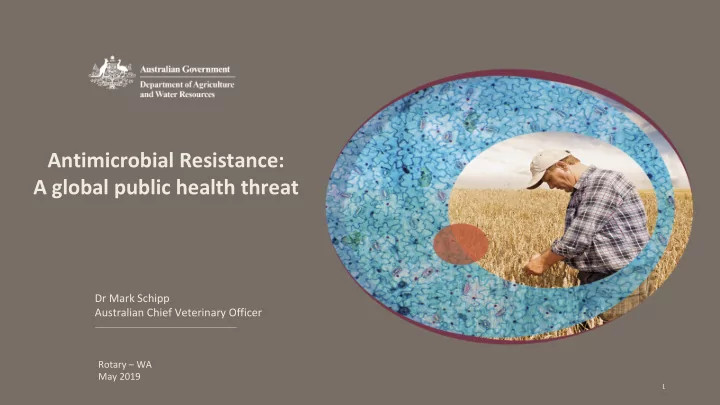

Antimicrobial Resistance: A global public health threat Dr Mark Schipp Australian Chief Veterinary Officer Rotary – WA May 2019 1
A very quick introduction What is AMR? - When micro-organisms evolve resistance to antimicrobial substances, like antibiotics. Why is AMR important? - AMR threatens the effective prevention and treatment of an ever-increasing range of infections. - An increasingly serious threat to global public health that requires action across all government sectors and society. 2
Nature of the problem • AMR is an increasing health concern in Australia and around the world. • If not addressed, simple infections could cause significant harm. • It is estimated that by 2050, ten million people will die every year as a result of AMR. • Even today, 700,000 people die of resistant infections every year. 3
Why do we have a problem?
Why is a vet speaking to us? • Most antibiotics are used in animal industries • AMR may be transmitted through food • A One Health issue One Health recognises the • interconnectedness of human, animal and environmental health. https://www.canada.ca/en/health-canada/services/ publications/drugs-health-products/tackling- antimicrobial-resistance-use-pan-canadian- framework-action.html 5
Antimicrobial use in Australia Reference adapted from: Reference: http://amr-review.org/sites/default/files/Antimicrobials%20in%20agriculture%20and%20the%20environment%20- http://www.safetyandquality.gov.au/wp-content/uploads/2016/06/AURA-2016-First-Australian-Report-on- %20Reducing%20unnecessary%20use%20and%20waste.pdf Antimicroibal-use-and-resistance-in-human-health.pdf
Antibiotic use in Australia • Australians are over-using antibiotics in human health. • Australia is the 11 th highest user of antibiotics out of 31 OECD countries. • In 2015, more than 30 million antibiotic scripts were provided through the Pharmaceutical Benefits Scheme. 7
What is being done? National AMR Strategy Key objectives : 1. Communication, education and training 2. Antimicrobial Stewardship 3. Surveillance 4. Infection prevention and control 5. Research and development 6. International engagement 7. Governance 8
Animal health key initiatives Best practice antibiotic prescribing guidelines – pigs § Veterinary antimicrobial stewardship online training program § Antimicrobial growth promotants (AGPs) – no label claims § OIE antimicrobial usage (AMU) annual questionnaire § Antibiotic Awareness Week § ASTAG Antibacterial list working group § Compendium report on antimicrobial stewardship efforts – livestock industries § Antimicrobial Stewardship Guidelines for the Australian Cattle Feedlot Industry § Factsheets on responsible antibiotic use – companion animals, livestock and horses § There are currently only three antibiotics registered with growth promotant claims, none of § which are currently important for human medicine
How are things in Australia? ü An excellent animal health status ü Australia already has a regulatory ü A best practice animal identification system working to minimise AMR and traceability system ü Australia has been very ü We have good partnerships between conservative in registering industry and government antibiotics for use in food ü Our systems are flexible and animals. responsive ü Nearly all antimicrobials used in ü We have good agricultural practices animals are Schedule 4 including on-farm hygiene and medicines. biosecurity ü Our feedlot industry are the first ü Many of our industries implement anywhere in the world to implement biosecurity manuals and QA systems a stewardship program, and how to ü Australian veterinarians have been use antimicrobials appropriately. proactively mitigating AMR for some ü Opportunities for Australia time. 10
Is food a risk? In Australia we have surveyed animals: ü Cattle (2013) – (Note: beef cattle, dairy cattle and veal calf) ü Pigs (2018) ü Chicken meat (2018) ü Chicken Eggs (2018) o Salmon o Barramundi o Chicken Egg – further work ? Others (Note: This relates to samples from healthy animals.) 11
What about imported food? Sourcing Certification Testing Disease status Cooked Processed Genetic material Residue testing Reference: https://www.spok.com/blog/ swiss-cheese-model-patient- safety-errors-closing-holes- message-accountability
Future Vision Ø Coordination – government/industry, One Health, internationally Ø Surveillance – human/animal/food/environment, use, resistance Ø Key data systems – Antimicrobials used, laboratory results, standardised, integrated Ø Resourced – community awareness, research, preventive
Summary • A time for action • Opportunities for the future $$ • More work needed Reference: http://www.oie.int/en/for-the-media/amr/ waaw2015/
Recommend
More recommend